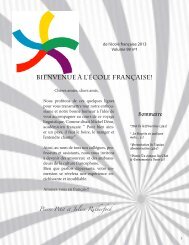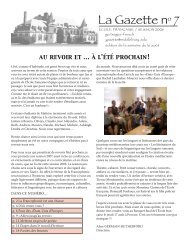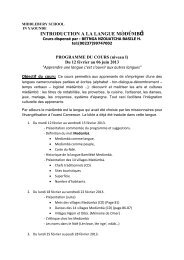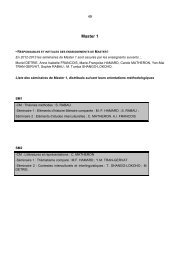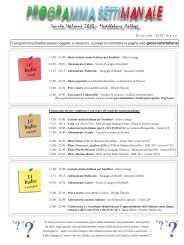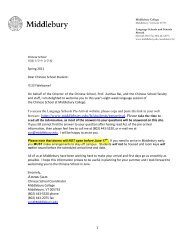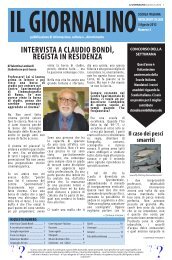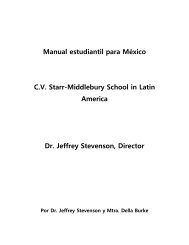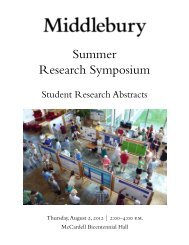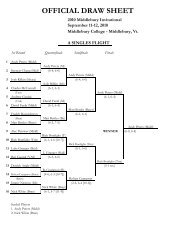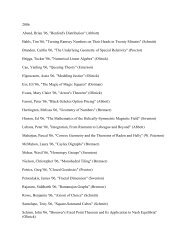2010 Catalog - Middlebury College
2010 Catalog - Middlebury College
2010 Catalog - Middlebury College
Create successful ePaper yourself
Turn your PDF publications into a flip-book with our unique Google optimized e-Paper software.
7431 The Movement of Modernism: Hardy, Lawrence, Woolf<br />
Ms. Green-Lewis/T, Th 2–4:45<br />
While British modernism is defined by its temporal, spatial, and stylistic<br />
movement, ambivalence about that movement is also one of its constants.<br />
In fact, some of the most memorable scenes in modernist works<br />
are those in which movement ceases completely. In this course we will<br />
focus on the representation of both movement and stasis, and we will<br />
consider how Hardy, Lawrence, and Woolf make use of each to conceptualize<br />
and make visible their experiences of beauty, loss, and the<br />
workings of memory. Please read James Joyce’s short story “The Dead”<br />
for the first class.<br />
Texts: James Joyce, “The Dead” (in any edition); Thomas Hardy,<br />
Tess of the D’Urbervilles and The Woodlanders (both Penguin); D.H.<br />
Lawrence, The Rainbow and Women in Love (both Penguin); Virginia<br />
Woolf, Mrs. Dalloway and The Waves (both HBJ/Harvest). There will<br />
be some secondary reading assigned as we go; please read as many of<br />
the novels in advance as you’re able.<br />
7437 Trauma and the Literature of Survival<br />
Ms. Sokoloff/M–F 11:15–12:15<br />
Hardly a day goes by that we don’t hear or read about the struggles of<br />
American soldiers returning home from Iraq and Afghanistan. This current<br />
obsession with veterans and their readjustment to civilian life has<br />
reawakened an interest in homecomings and the dynamics of survival<br />
that has preoccupied artists and writers since ancient Greece. In this<br />
course we will examine the relationship between trauma and representation<br />
by examining the archetypal figure of survival, the returned<br />
soldier. Our study begins with the First World War, when the term<br />
“shell shock” was coined, and extends to more recent times when the<br />
broken-down WWI soldier and his descendants continue to animate<br />
the literary imagination. In his own historical context, the shell-shocked<br />
soldier unraveled traditional notions of war, social class, manliness, and<br />
mental illness. As a literary figure, he becomes a site for contesting fundamental<br />
assumptions about home, memory, identity, ordinary experience,<br />
and literary representation itself. Through supplementary materials<br />
and student research reports, the course will provide opportunities for<br />
us to juxtapose historical/medical representations of shell-shocked soldiers<br />
with poetic/literary ones and to probe the similarities among the<br />
literatures of various wars. While we will focus primarily on World<br />
War I, we will necessarily find echoes of “shell shock” in the PTSD<br />
syndromes of today. For background on WWI, please look at Paul<br />
Fussell’s The Great War and Modern Memory before the session begins.<br />
We will also draw heavily on Jonathan Shay’s two books, Achilles in<br />
Vietnam and Odysseus in America, throughout the summer, and you<br />
should read them before you arrive at Bread Loaf.<br />
Texts: Erich Maria Remarque, The Road Back (Ballantine); Tim<br />
O’Brien, In the Lake of the Woods (Mariner); Pat Barker, Regeneration<br />
(Penguin); Rebecca West, The Return of the Soldier (Modern Library);<br />
Virginia Woolf, Mrs. Dalloway (Harcourt); Toni Morrison, Sula<br />
(Vintage); Philip Roth, The Human Stain (Vintage).<br />
7455 Fiction of Empire and the Breakup of Empire<br />
Ms. Sabin/T, Th 2–4:45<br />
Through close study of selected Victorian, modern, and contemporary<br />
texts, the seminar will examine continuities and ruptures between colonial<br />
and postcolonial fiction in English. Novels and short stories will be<br />
considered in relation to a variety of critical and theoretical controversies<br />
in current postcolonial studies. We will discuss the participation of<br />
the English novel in the construction and also the critique of imperialism,<br />
the ambiguous status of the English language in the turn against the<br />
colonialist mentality, and more recent questioning of the term “postcolonial”<br />
itself. This course moves fast, especially at the beginning.<br />
It will prove very important to have done a substantial amount of the<br />
primary reading before arrival, at least The Mystery of Edwin Drood,<br />
A Passage to India, The Inheritance of Loss, The Romantics, and A Bend in<br />
the River. Specific assignments in critical reading and a few films will<br />
accompany the primary texts during the course, along with photocopied<br />
extracts from some contemporary primary readings unavailable<br />
for purchase in print. (This course can be used to satisfy either a Group III<br />
or a Group V requirement; students should indicate their choice at the time of<br />
registration.)<br />
Texts: Charles Dickens, The Mystery of Edwin Drood (Penguin); Rudyard<br />
Kipling, Selected Stories (Penguin); E.M. Forster, A Passage to India<br />
(Harvest); Pankaj Mishra, The Romantics (Anchor); Kiran Desai, The<br />
Inheritance of Loss (Grove); Joseph Conrad, Heart of Darkness (Norton<br />
Critical Ed.); Chinua Achebe, Things Fall Apart (Anchor); V.S. Naipaul,<br />
A Bend in the River (Vintage); Ngugi wa Thiong’o, Weep Not, Child<br />
(Heinemann); Wole Soyinka, Aké: The Years of Childhood (Vintage);<br />
Ama Ata Aidoo, Our Sister Killjoy (Longman).<br />
7456 Caryl Churchill and Tom Stoppard<br />
Mr. Cadden/M–F 10–11<br />
This course will focus on two of England’s most distinguished contemporary<br />
playwrights—Caryl Churchill and Tom Stoppard. Both<br />
are celebrated for their imaginative theatricality and their engagement<br />
with social, cultural, and literary history. Both began their careers in<br />
England’s “swinging” sixties. She has described herself as a feminist and<br />
socialist playwright; he has eschewed such adjectives, while churning<br />
out plays that suggest a no less gendered and political point of view.<br />
Her work often has its origins in her collaboration with theater collectives;<br />
his has been a matter of individual production. Her work has become<br />
more and more elliptical; his has become less and less so. Her work is<br />
a notoriously difficult “read,” dependent upon a life in the theater; his<br />
work has been canonized as part of “dramatic literature.” “Lit Crit”<br />
knows just what to do with him; she’s a tougher case. In partnership<br />
with the Bread Loaf Acting Ensemble, which will stage Churchill’s<br />
Mad Forest this summer, we will take a close look at major work by<br />
these equally excellent but decidedly different theatrical talents.<br />
Texts: Caryl Churchill, Vinegar Tom and Cloud Nine in Plays: One<br />
(Routledge); Top Girls and Serious Money in Plays: Two (Methuen);<br />
Mad Forest in Plays: Three (Nick Hern); and Far Away and A Number in<br />
Plays: Four (Nick Hern). Tom Stoppard: Rosencrantz and Guildenstern are<br />
Dead, Jumpers, Travesties, The Real Thing, Arcadia, The Invention of Love,<br />
and Rock ‘n’ Roll (all of the Stoppard plays, except Arcadia, are Grove;<br />
Arcadia is Faber & Faber). Before the first class, students should also read<br />
Herta Müller, The Land of Green Plums (Northwestern) which,<br />
like Mad Forest, is set in Ceaus‚escu’s Romania; Müller won the<br />
2009 Nobel Prize for Literature.<br />
Heading back from breakfast in Vermont.<br />
29<br />
VERMONT



